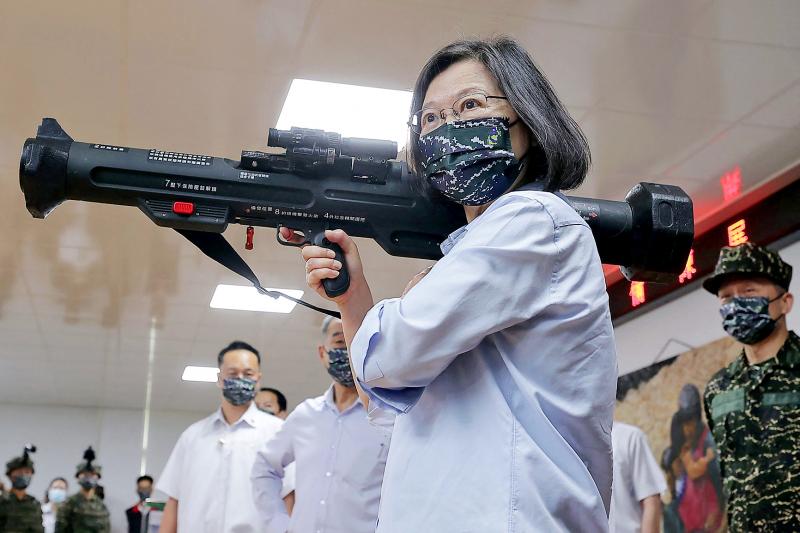For Taiwan, the United States, and its allies it is crucial to step up countermeasures to the Chinese Communist Party’s (CCP) campaign of military intimidation and coercion lest it become confident it can get away with minor aggressions contributing to confidence to undertake an invasion of Taiwan.
Taiwan President Tsai Ing-wen (蔡英文) appears to understand. During a June 2, 2022 Dragon Boat Festival weekend tour of Taiwan’s 66th Marine Brigade, without warning she paused to pick up and get the feel of the Taiwan-designed and made Kestrel shoulder-fired infantry rocket.
In that moment President Tsai herself was showing Taiwanese and the free world that it is possible to defy CCP invasion and hegemony — if she can fire an invasion-vehicle-killing rocket, so can every other adult citizen of Taiwan.

It was a most serious gesture that recalled British Prime Minister Winston Churchill’s late July 1940 visit to Hartlepool to inspect coastal defenses, where he was famously photographed with a Thompson submachinegun, clenching his cigar.
Churchill was rallying Britons with a much-needed image of defiance during a time of justified fears of a massive German amphibious invasion, as the Battle of Britain was far from being decided.
Today the Battle for Taiwan is far from being decided and it is possible to keep it that way. Yet it is important to consider how far the CCP and its People’s Liberation Army (PLA) have come.

Photo: the Presidential Office via AFP
During the Taiwan crises of the 1950s it was the Taiwan Air Force that fought in skies over China — not Taiwan. The United States, a formal military ally of Taiwan, saw fit to send 20 kiloton tactical nuclear warhead-armed Matador cruise missiles to Taiwan, and was ready to use them.
But with help from American, European, Israeli, and then Russian technology, CCP leader Deng Xiaoping (鄧小平) was able to begin China’s rearmament, which by 1995 his successor Jiang Zemin (江澤民) began to focus on Taiwan, firing DF-15 and DF-11 missiles to intimidate the island’s voters in 1995 and 1996.
Then in 1999 a much stronger PLA Air Force (PLAAF) began patrols out to the mid-line, effectively taking control of half of the Taiwan Strait, an aerial presence that increased in the decade of the 2000s under Hu Jintao (胡錦濤).
Current CCP leader Xi Jinping (習近平) exploits new waves of PLAAF and PLA Navy (PLAN) modernization by escalating to what has become a virtual war around Taiwan, starting around 2015 with occasional H-6K nuclear-capable bomber patrols around Taiwan, to now the third year of near daily groups of combat and intelligence support aircraft harassing the island.
In May 2020 this campaign of intimidation escalated on two levels. For the first time the PLAN Liaoning aircraft carrier, operating in a full carrier battle group east of Taiwan, coordinated with large groups of combat aircraft operating south and east of the island.
Then on May 24, four PLAAF H-6K bombers, and two Russian Air Force Tu-95MS bombers joined for the fourth China-Russia joint bomber exercise.
First,over the Sea of Japan, and then to the area where the Liaoning carrier battle group was exercising, this demonstrated anew that Russia will support CCP aggression against Taiwan and potentially engage in joint nuclear operations with the PLA against the United States and other countries that may come to defend Taiwan.
So far, the CCP and PLA have not shot at Taiwanese aircraft responding to PLA intimidation exercises, and have not shot down any of the many Japanese, US, and allied aircraft that have responded to PLA aerial intimidation of Japan, Taiwan, or in the South China Sea.
But on May 26 the PLA demonstrated it could cross this line, when somewhere in the South China Sea, a PLAAF J-16 strike fighter harassed a Royal Australian Air Force P-8A anti-submarine patrol aircraft by firing chaff flares while sharply crossing close to the nose of the P-8A.
These chaff flares only had time to create small blooms of metal particles, but they could be dense enough to damage the engines of the Australian patrol aircraft, and if that damage was done near new Chinese bases in the Paracel or Spratly Island groups, far from diversion airfields in the Philippines or Malaysia, the possibility arises that the P-8A would have to land at a new Chinese base where it would be captured and exploited for intelligence.
That China will continue to push the limits of its coercive exercises even to start “killing” Taiwan, US, Japanese, or Australian aircraft has been amply demonstrated by two long-term military campaigns in Asia that China is winning.
First, with practically no physical push-back, China has succeeded in bullying Southeast Asia and the United States since the mid-1970s with a gradual campaign of South China Sea islet occupation culminating in the late-2000s rapid construction of new large air-naval-missile bases in the Spratly Island Group.
Second, since the beginning of the 2010s, suffering no sanctions or penalty, China has transferred enough missile-related technology to help turn North Korea into a nuclear missile state.
In addition to increasing interceptions of PLA aircraft by Taiwan and Japan air force fighters, and more recent Japanese use of small aircraft carriers to shadow larger PLAN carriers, there has begun a sophisticated US military response to China’s escalating intimidation.
This has included regular US Navy exercise patrols, sometimes in response to PLAN exercises, and a large number of US aircraft patrol operations. This activity has not been “advertised” by the Pentagon, perhaps to prevent domestic alarm.
Now, however, there is a requirement to begin demonstrating to the PLA that its aggression will result in massive losses of PLAN ships and PLAAF aircraft.
This is needed both to deter the CCP from beginning to kill occasionally as part of its harassment, and to dissuade it from deciding to undertake major assaults like an invasion of Taiwan.
As the PLA has long used simulations of fixed Japanese and US bases in Asia for precision long-range missile exercises, and has developed mobile target platforms to practice anti-ship ballistic missile strikes against US Navy aircraft carriers, it is time to give the CCP some of the same medicine.
As the PLA will rely mainly on large “civilian” roll-on-roll-off (RORO) ferries and civilian cargo and passenger aircraft to transport the bulk of its soldiers, armor, and occupation forces to Taiwan, the US, Japan and Taiwan should build large plasticard simulations of these ferries that blow up spectacularly when hit by anti-ship missiles.
In the same vein, Taiwan could easily build large and accurate billboard representations of different Chinese airframes to be used for target practice by Taiwanese Marines, Army, Police and Reserve Force units armed with anti-aircraft artillery, and even Kestrel shoulder-launched rockets.
Another impressive countermeasure to CCP intimidation would be to increase US-South Korean joint force exercises to levels approaching 200,000 troops, as during the “Team Spirit” exercises of the 1980s.
In addition, Japan and the US could begin a series of large amphibious and airborne force assaults to defend or recapture sparsely populated islands in the Ryukyu Island Chain, especially some that are close to Taiwan.
The CCP and the PLA are using their campaigns of intimidation and coercion to help train for real wars against Taiwan, Japan, South Korea, the Philippines, Australia, India and the United States.
It is time that the United States, its allies, and Taiwan, start campaigns of counter-intimidation training with increasing kinetic effects that demonstrate to the CCP that it will lose any wars that it starts.
Richard D. Fisher, Jr is a senior fellow with the International Assessment and Strategy Center.
Taiwan-India relations appear to have been put on the back burner this year, including on Taiwan’s side. Geopolitical pressures have compelled both countries to recalibrate their priorities, even as their core security challenges remain unchanged. However, what is striking is the visible decline in the attention India once received from Taiwan. The absence of the annual Diwali celebrations for the Indian community and the lack of a commemoration marking the 30-year anniversary of the representative offices, the India Taipei Association and the Taipei Economic and Cultural Center, speak volumes and raise serious questions about whether Taiwan still has a coherent India
Recent media reports have again warned that traditional Chinese medicine pharmacies are disappearing and might vanish altogether within the next 15 years. Yet viewed through the broader lens of social and economic change, the rise and fall — or transformation — of industries is rarely the result of a single factor, nor is it inherently negative. Taiwan itself offers a clear parallel. Once renowned globally for manufacturing, it is now best known for its high-tech industries. Along the way, some businesses successfully transformed, while others disappeared. These shifts, painful as they might be for those directly affected, have not necessarily harmed society
Democratic Progressive Party (DPP) spokesman Justin Wu (吳崢) on Monday rebuked seven Chinese Nationalist Party (KMT) lawmakers for stalling a special defense budget and visiting China. The legislators — including Weng Hsiao-ling (翁曉玲), Yeh Yuan-chih (葉元之) and Lin Szu-ming (林思銘) — attended an event in Xiamen, China, over the weekend hosted by the Xiamen Taiwan Businessmen Association, where they met officials from Beijing’s Taiwan Affairs Office (TAO). “Weng’s decision to stall the special defense budget defies majority public opinion,” Wu said, accusing KMT legislators of acting as proxies for Beijing. KMT Legislator Wu Tsung-hsien (吳宗憲), acting head of the party’s Culture and Communications
Legislators of the opposition parties, consisting of the Chinese Nationalist Party (KMT) and the Taiwan People’s Party (TPP), on Friday moved to initiate impeachment proceedings against President William Lai (賴清德). They accused Lai of undermining the nation’s constitutional order and democracy. For anyone who has been paying attention to the actions of the KMT and the TPP in the legislature since they gained a combined majority in February last year, pushing through constitutionally dubious legislation, defunding the Control Yuan and ensuring that the Constitutional Court is unable to operate properly, such an accusation borders the absurd. That they are basing this